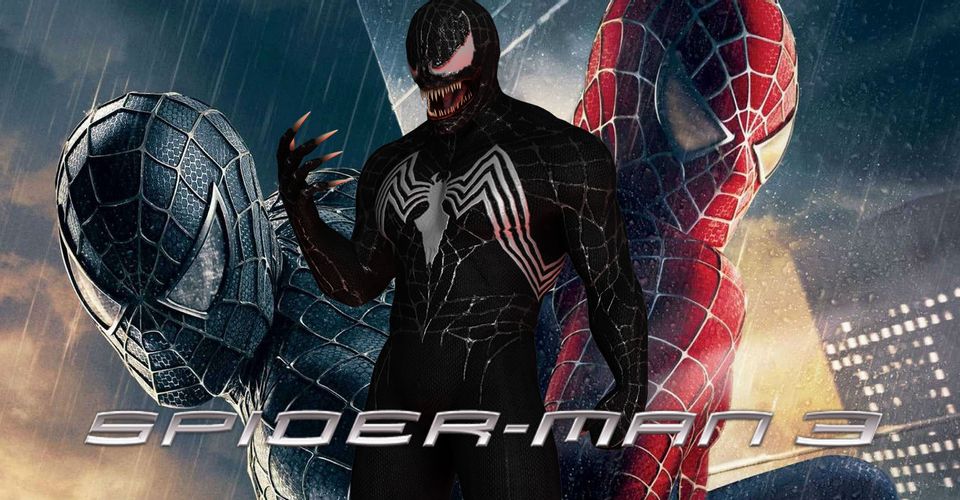What Went Wrong With Spider-Man 3

How did Spider-Man 3 take Sony’s original web-slinger movie trilogy from the top of the superhero tree to the bottom of the bathtub? As recently reported, Marvel Studios are lining up Sam Raimi to take over from Scott Derrickson on Doctor Strange In The Multiverse of Madness and it would be an understatement to say fans are eager to see what the renowned director could do with the inherent madness of Dr. Stephen Strange. Aside from his pioneering Evil Dead franchise, Raimi is perhaps best known for directing the original Spider-Man movies starring Tobey Maguire as the titular web-slinger.
Both 2002’s Spider-Man and the 2004 follow-up were instrumental in establishing superheroes as a key part of the cinematic calendar, and struck the sweet balance between drawing in a new generation of young Spidey fans and pleasing grown-ups that had harbored an obsession with the Marvel character since his days as a cartoon meme machine. It was arguably this mixture of mainstream popularity and geek appeal that paved the way for the MCU while it was merely a twinkle in Kevin Feige’s eye.
After a pair of financial juggernauts, it seemed like Raimi’s Spider-Man franchise could do no wrong, but then along came a Spider-Man 3 to prove that this new generation of cinematic superheroes was still susceptible to the Batman & Robin treatment if handled improperly. Raimi and the original trilogy cast were denied the opportunity to set the record straight when Spider-Man 4 fell through, leaving the third film as an awkward finale to an otherwise stellar franchise. Here’s exactly where Spider-Man 3 went wrong.
Spider-Man 3 Had Too Many Villains

Raimi’s first two Spider-Man movies benefited hugely from orbiting around one single villain – Willem Dafoe’s Green Goblin in the first and Alfred Molina’s Doctor Octopus in the sequel. This approach ensured both Spidey stories had a laser-sharp focus, and afforded both baddies ample time to develop into well-rounded villains, rather than generic, one-dimensional cackling evil-doers. In both cases, the audience see how great men can become corrupted by power, and these transformations make Spidey’s eventual, inevitable victories so much sweeter. Oddly, Spider-Man 3 swung in completely the opposite direction, casting Topher Grace as Venom and Thomas Haden Church as Sandman, while finally transforming James Franco’s Harry Osborn into Green Goblin.
All three end up competing for screen time and, with no clear victor, only a tangled web of mostly unrelated storylines remains, leaving the audience picking through the messy deluge of plot. Where the original Green Goblin and Doc Ock flourished by being featured antagonists, Sandman becomes a sideshow, his meaningful origin story quickly giving way to something more formulaic. But it’s Harry Osborn’s descent that suffers most. Concluding a storyline sown in the 2002 original, Harry’s taking over of the Green Goblin mantle should’ve been momentous, instead it buckled under the weight of too much going on and ended feeling rushed and contrived.
Amnesia as a plot device is never an encouraging sign, but with Harry’s resentment of Spider-Man entirely built upon a misunderstanding, a convenient spout of memory loss is required in the film’s first half to avoid an early resolution. When Harry regains his memories as quickly as he lost them, all it takes to remedy his anger is a quick conversation with the butler, and he’s Peter’s best pal again. Given more room to develop naturally, Harry’s redemption could’ve been the defining moment of the entire trilogy, but he wasn’t the only villain to be let down by Spider-Man 3…
THIS Is Venom?!

There was a palpable excitement when Venom was revealed as one of Spider-Man 3‘s villains, and a just-as-palpable deflated groan when audiences finally saw the iconic comic character in live-action. In fairness, taking a crazed symbiote from the comic books and translating that fantastical alien for the big screen was no easy task, but Spider-Man 3‘s iteration of the villain is quite far from what fans knew and loved. The Venom of the comics was famed for being a brutal extra-terrestrial entity that took over its host, but Topher Grace’s version largely retained the goofy and unassuming personality of Eddie Brock, sucking out the danger of what Venom should be.
Spider-Man 3‘s Venom was more of a plot device to make other characters turn bad than an evil being in his own right, and Venom’s cause wasn’t helped by a lackluster visual appearance that rarely showcased the authentic comic design. Just like Harry Osborn and Sandman, Eddie Brock’s metamorphosis is vastly underdeveloped, rocketing from regular guy to unhinged killer in the space of a few scenes – an unlikely turnaround, even with a symbiote in the mix. Sam Raimi has admitted he wasn’t completely on board with the idea of Venom coming into his universe, but was convinced to do so by producer, Avi Arad, who has since accepted responsibility for the decision. Whoever made the call, the dark, other-worldly Venom was an awkward fit for Raimi’s more grounded Spidey.
Peter Parker Goes Emo

Spider-Man 3‘s woes can largely be surmised by one infamous scene, but that’s just the tip of a floppy-haired, black eyeliner-ed iceberg. While under the influence of the Venom symbiote, Peter Parker is supposed to lean into his darker instincts, but Spider-Man‘s interpretation of said darkness wasn’t anywhere close to what audiences were expecting. Tobey Maguire prances around a jazz club like a gazelle performing a mating ritual, and the “now dig on this” line is the epitome of cringe, though his Venom-inspired strut through the streets of New York certainly comes close. It’s all supposed to be bad, of course, but where the intention is perhaps to provoke laughter at Peter’s misplaced overconfidence, it’s Spider-Man 3 itself that ends up the butt of the joke.
If Peter’s detestable personality wasn’t enough of a deterrent, his physical makeover wasn’t much better. By wearing all-black outfits, donning guy-liner and bringing in a sweeping fringe, Spider-Man 3 mirrored the emo culture that was gaining popularity at the time of the release, and the parallel was underlined by a shared teenage angst. Possibly because Tobey Maguire was already in his 30s at this point, Peter Parker’s My Chemical Makeover did nothing for those who were fans of the emo trend, and even less for those who weren’t. More problematically, Spider-Man 3‘s emo Peter was straight-up a thoroughly unlikable guy. Spending half a movie hating on the protagonist is never likely to yield positive results, especially when the Uncle Ben origin story was retconned to help demonstrate Peter’s new amoral characterization.
Mary Jane Watson

If there’s one thing the Andrew Garfield era of Spider-Man movies did better than the original trilogy, it was female leads, with Emma Stone’s Gwen Stacy by far the more rounded and interesting character. By contrast, Kirsten Dunst’s Mary Jane never strays far from the archetype of a comic book love interest throughout her first 2 Spider-Man movies. MJ gets captured when Maguire needs someone to rescue and goes into ‘girl next door’ mode when the film calls for romance, but her by-the-numbers role takes a turn for the worse in Spider-Man 3 when, just like Peter Parker, her affable personality gives way to something less endearing.
MJ’s initial spark of jealousy towards Peter and her subsequent growing closer with Harry is frustrating after spending the previous 2 films watching Peter and Mary Jane’s relationship blossom, and only serves to turn viewers away from yet another of Spider-Man 3‘s main characters. MJ’s various song and dance numbers fare little better than Peter’s, driving the deterioration of her character home further, and by the time they reconcile in the finale, only the most patient of viewers will still be emotionally invested in the couple’s romance. Maybe because of Peter and MJ’s breakup, Spider-Man 3 highlights the lack of depth in Dunst’s damsel in distress more than ever before.
Trying To Raise The Stakes

Admirably, Sam Raimi has held his hands up in acknowledgement of Spider-Man 3‘s failure and publicly admitted the film was the worst of the trilogy. Among the problems the director himself cites are the inclusion of Venom, who Raimi freely concedes was not a character he loved, and trying too hard to outdo the previous movies by ‘going big’ instead of continuing the evolution of character and story that had already been established. Certainly, it’s hard to disagree with Raimi’s suggestion that Spider-Man 3 fell down mainly because it tried to do too much. With the introduction of Venom and the character changes the symbiote’s possession brings, Harry’s arc pulls the short straw and Peter’s relationship with MJ goes out of the window, thus existing stories are sacrificed for a brand new gimmick.
And as Raimi implies, all of the ingredients for a strong third movie were already in place. Harry Osborn was primed to become the main villain, perhaps with Sandman as a secondary antagonist, and Spider-Man 3 could’ve adapted the comic books’ wedding storyline, paying off Peter and MJ’s relationship rather than regressing it. Alternatively, Raimi might’ve substituted Venom and Sandman for a villain he held closer to his heart (Kraven The Hunter and Vulture were reportedly considered at various points in the trilogy’s production) and Harry could’ve then played the secondary bad guy role. Either recipe would surely result in a less forced movie than Spider-Man 3 ended up being and, just maybe, Tobey Maguire would’ve stuck around long enough to join the MCU.
About The Author


















